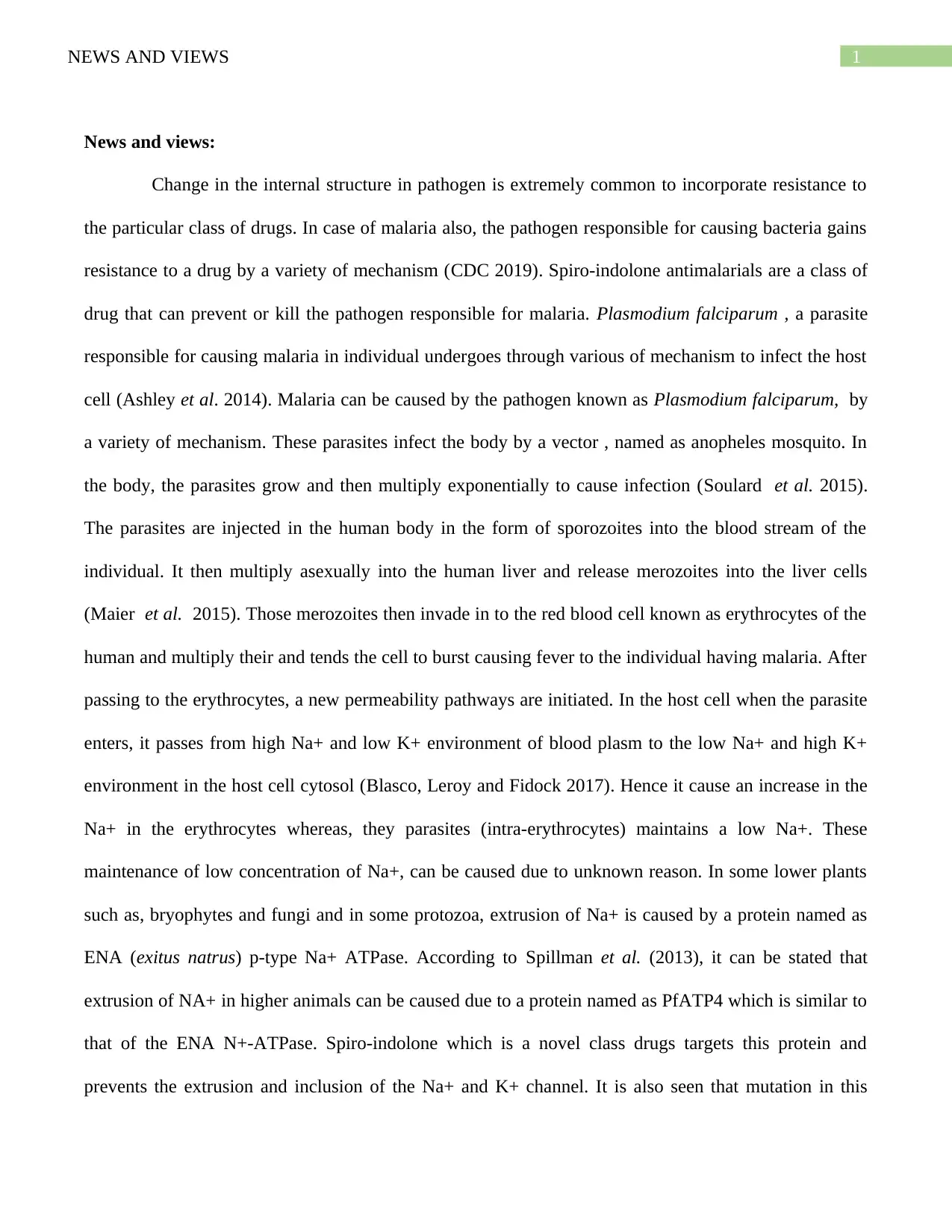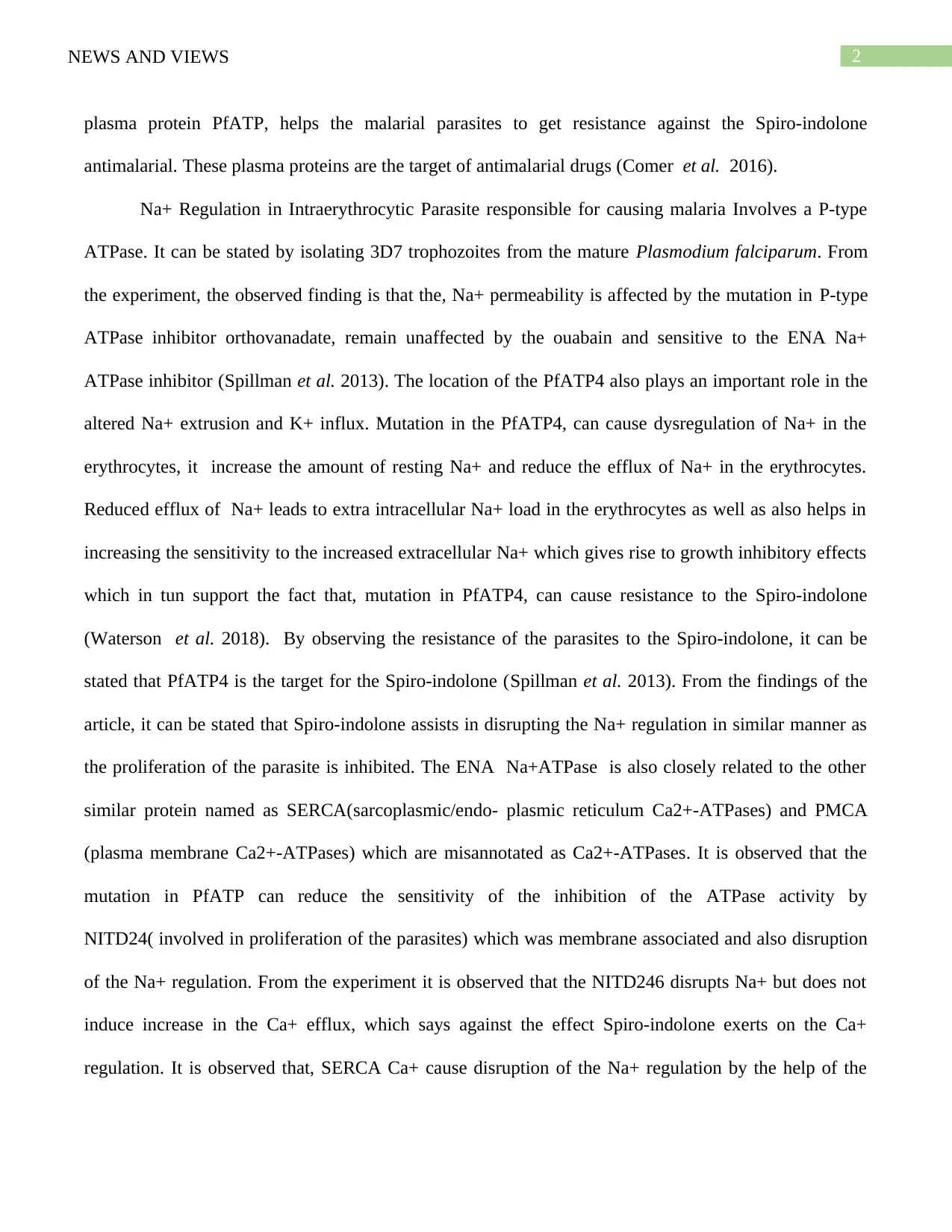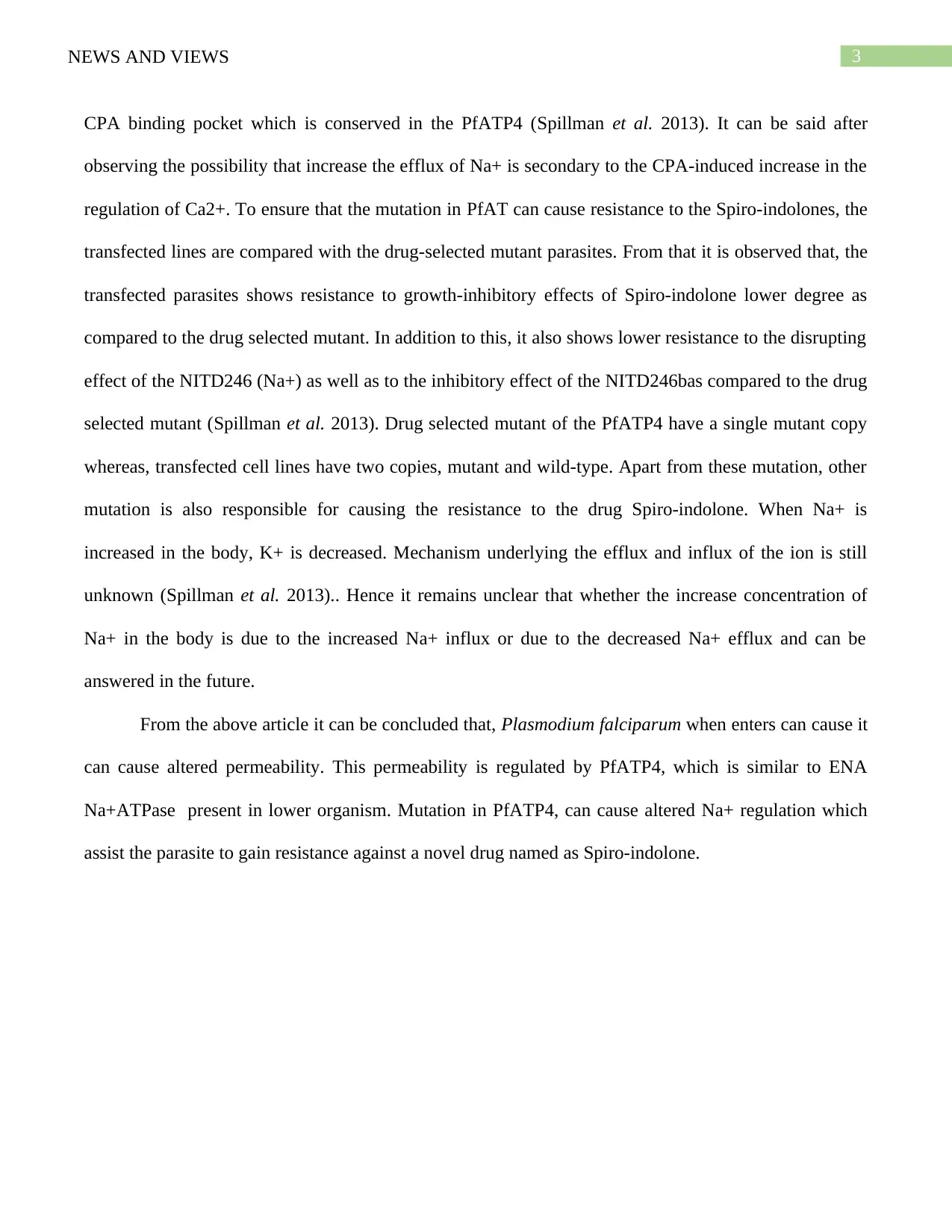Na+ Regulation in Intraerythrocytic Parasite responsible for causing malaria Involves a P-type ATPase
VerifiedAdded on 2023/03/29
|5
|1292
|80
AI Summary
This article discusses the role of PfATP4, a P-type ATPase, in the regulation of Na+ in the intraerythrocytic parasite responsible for causing malaria and its implications for drug resistance.
Contribute Materials
Your contribution can guide someone’s learning journey. Share your
documents today.

Running head: NEWS AND VIEWS
News and Views
Name of the student:
Name of the university:
Author note:
News and Views
Name of the student:
Name of the university:
Author note:
Secure Best Marks with AI Grader
Need help grading? Try our AI Grader for instant feedback on your assignments.

1NEWS AND VIEWS
News and views:
Change in the internal structure in pathogen is extremely common to incorporate resistance to
the particular class of drugs. In case of malaria also, the pathogen responsible for causing bacteria gains
resistance to a drug by a variety of mechanism (CDC 2019). Spiro-indolone antimalarials are a class of
drug that can prevent or kill the pathogen responsible for malaria. Plasmodium falciparum , a parasite
responsible for causing malaria in individual undergoes through various of mechanism to infect the host
cell (Ashley et al. 2014). Malaria can be caused by the pathogen known as Plasmodium falciparum, by
a variety of mechanism. These parasites infect the body by a vector , named as anopheles mosquito. In
the body, the parasites grow and then multiply exponentially to cause infection (Soulard et al. 2015).
The parasites are injected in the human body in the form of sporozoites into the blood stream of the
individual. It then multiply asexually into the human liver and release merozoites into the liver cells
(Maier et al. 2015). Those merozoites then invade in to the red blood cell known as erythrocytes of the
human and multiply their and tends the cell to burst causing fever to the individual having malaria. After
passing to the erythrocytes, a new permeability pathways are initiated. In the host cell when the parasite
enters, it passes from high Na+ and low K+ environment of blood plasm to the low Na+ and high K+
environment in the host cell cytosol (Blasco, Leroy and Fidock 2017). Hence it cause an increase in the
Na+ in the erythrocytes whereas, they parasites (intra-erythrocytes) maintains a low Na+. These
maintenance of low concentration of Na+, can be caused due to unknown reason. In some lower plants
such as, bryophytes and fungi and in some protozoa, extrusion of Na+ is caused by a protein named as
ENA (exitus natrus) p-type Na+ ATPase. According to Spillman et al. (2013), it can be stated that
extrusion of NA+ in higher animals can be caused due to a protein named as PfATP4 which is similar to
that of the ENA N+-ATPase. Spiro-indolone which is a novel class drugs targets this protein and
prevents the extrusion and inclusion of the Na+ and K+ channel. It is also seen that mutation in this
News and views:
Change in the internal structure in pathogen is extremely common to incorporate resistance to
the particular class of drugs. In case of malaria also, the pathogen responsible for causing bacteria gains
resistance to a drug by a variety of mechanism (CDC 2019). Spiro-indolone antimalarials are a class of
drug that can prevent or kill the pathogen responsible for malaria. Plasmodium falciparum , a parasite
responsible for causing malaria in individual undergoes through various of mechanism to infect the host
cell (Ashley et al. 2014). Malaria can be caused by the pathogen known as Plasmodium falciparum, by
a variety of mechanism. These parasites infect the body by a vector , named as anopheles mosquito. In
the body, the parasites grow and then multiply exponentially to cause infection (Soulard et al. 2015).
The parasites are injected in the human body in the form of sporozoites into the blood stream of the
individual. It then multiply asexually into the human liver and release merozoites into the liver cells
(Maier et al. 2015). Those merozoites then invade in to the red blood cell known as erythrocytes of the
human and multiply their and tends the cell to burst causing fever to the individual having malaria. After
passing to the erythrocytes, a new permeability pathways are initiated. In the host cell when the parasite
enters, it passes from high Na+ and low K+ environment of blood plasm to the low Na+ and high K+
environment in the host cell cytosol (Blasco, Leroy and Fidock 2017). Hence it cause an increase in the
Na+ in the erythrocytes whereas, they parasites (intra-erythrocytes) maintains a low Na+. These
maintenance of low concentration of Na+, can be caused due to unknown reason. In some lower plants
such as, bryophytes and fungi and in some protozoa, extrusion of Na+ is caused by a protein named as
ENA (exitus natrus) p-type Na+ ATPase. According to Spillman et al. (2013), it can be stated that
extrusion of NA+ in higher animals can be caused due to a protein named as PfATP4 which is similar to
that of the ENA N+-ATPase. Spiro-indolone which is a novel class drugs targets this protein and
prevents the extrusion and inclusion of the Na+ and K+ channel. It is also seen that mutation in this

2NEWS AND VIEWS
plasma protein PfATP, helps the malarial parasites to get resistance against the Spiro-indolone
antimalarial. These plasma proteins are the target of antimalarial drugs (Comer et al. 2016).
Na+ Regulation in Intraerythrocytic Parasite responsible for causing malaria Involves a P-type
ATPase. It can be stated by isolating 3D7 trophozoites from the mature Plasmodium falciparum. From
the experiment, the observed finding is that the, Na+ permeability is affected by the mutation in P-type
ATPase inhibitor orthovanadate, remain unaffected by the ouabain and sensitive to the ENA Na+
ATPase inhibitor (Spillman et al. 2013). The location of the PfATP4 also plays an important role in the
altered Na+ extrusion and K+ influx. Mutation in the PfATP4, can cause dysregulation of Na+ in the
erythrocytes, it increase the amount of resting Na+ and reduce the efflux of Na+ in the erythrocytes.
Reduced efflux of Na+ leads to extra intracellular Na+ load in the erythrocytes as well as also helps in
increasing the sensitivity to the increased extracellular Na+ which gives rise to growth inhibitory effects
which in tun support the fact that, mutation in PfATP4, can cause resistance to the Spiro-indolone
(Waterson et al. 2018). By observing the resistance of the parasites to the Spiro-indolone, it can be
stated that PfATP4 is the target for the Spiro-indolone (Spillman et al. 2013). From the findings of the
article, it can be stated that Spiro-indolone assists in disrupting the Na+ regulation in similar manner as
the proliferation of the parasite is inhibited. The ENA Na+ATPase is also closely related to the other
similar protein named as SERCA(sarcoplasmic/endo- plasmic reticulum Ca2+-ATPases) and PMCA
(plasma membrane Ca2+-ATPases) which are misannotated as Ca2+-ATPases. It is observed that the
mutation in PfATP can reduce the sensitivity of the inhibition of the ATPase activity by
NITD24( involved in proliferation of the parasites) which was membrane associated and also disruption
of the Na+ regulation. From the experiment it is observed that the NITD246 disrupts Na+ but does not
induce increase in the Ca+ efflux, which says against the effect Spiro-indolone exerts on the Ca+
regulation. It is observed that, SERCA Ca+ cause disruption of the Na+ regulation by the help of the
plasma protein PfATP, helps the malarial parasites to get resistance against the Spiro-indolone
antimalarial. These plasma proteins are the target of antimalarial drugs (Comer et al. 2016).
Na+ Regulation in Intraerythrocytic Parasite responsible for causing malaria Involves a P-type
ATPase. It can be stated by isolating 3D7 trophozoites from the mature Plasmodium falciparum. From
the experiment, the observed finding is that the, Na+ permeability is affected by the mutation in P-type
ATPase inhibitor orthovanadate, remain unaffected by the ouabain and sensitive to the ENA Na+
ATPase inhibitor (Spillman et al. 2013). The location of the PfATP4 also plays an important role in the
altered Na+ extrusion and K+ influx. Mutation in the PfATP4, can cause dysregulation of Na+ in the
erythrocytes, it increase the amount of resting Na+ and reduce the efflux of Na+ in the erythrocytes.
Reduced efflux of Na+ leads to extra intracellular Na+ load in the erythrocytes as well as also helps in
increasing the sensitivity to the increased extracellular Na+ which gives rise to growth inhibitory effects
which in tun support the fact that, mutation in PfATP4, can cause resistance to the Spiro-indolone
(Waterson et al. 2018). By observing the resistance of the parasites to the Spiro-indolone, it can be
stated that PfATP4 is the target for the Spiro-indolone (Spillman et al. 2013). From the findings of the
article, it can be stated that Spiro-indolone assists in disrupting the Na+ regulation in similar manner as
the proliferation of the parasite is inhibited. The ENA Na+ATPase is also closely related to the other
similar protein named as SERCA(sarcoplasmic/endo- plasmic reticulum Ca2+-ATPases) and PMCA
(plasma membrane Ca2+-ATPases) which are misannotated as Ca2+-ATPases. It is observed that the
mutation in PfATP can reduce the sensitivity of the inhibition of the ATPase activity by
NITD24( involved in proliferation of the parasites) which was membrane associated and also disruption
of the Na+ regulation. From the experiment it is observed that the NITD246 disrupts Na+ but does not
induce increase in the Ca+ efflux, which says against the effect Spiro-indolone exerts on the Ca+
regulation. It is observed that, SERCA Ca+ cause disruption of the Na+ regulation by the help of the

3NEWS AND VIEWS
CPA binding pocket which is conserved in the PfATP4 (Spillman et al. 2013). It can be said after
observing the possibility that increase the efflux of Na+ is secondary to the CPA-induced increase in the
regulation of Ca2+. To ensure that the mutation in PfAT can cause resistance to the Spiro-indolones, the
transfected lines are compared with the drug-selected mutant parasites. From that it is observed that, the
transfected parasites shows resistance to growth-inhibitory effects of Spiro-indolone lower degree as
compared to the drug selected mutant. In addition to this, it also shows lower resistance to the disrupting
effect of the NITD246 (Na+) as well as to the inhibitory effect of the NITD246bas compared to the drug
selected mutant (Spillman et al. 2013). Drug selected mutant of the PfATP4 have a single mutant copy
whereas, transfected cell lines have two copies, mutant and wild-type. Apart from these mutation, other
mutation is also responsible for causing the resistance to the drug Spiro-indolone. When Na+ is
increased in the body, K+ is decreased. Mechanism underlying the efflux and influx of the ion is still
unknown (Spillman et al. 2013).. Hence it remains unclear that whether the increase concentration of
Na+ in the body is due to the increased Na+ influx or due to the decreased Na+ efflux and can be
answered in the future.
From the above article it can be concluded that, Plasmodium falciparum when enters can cause it
can cause altered permeability. This permeability is regulated by PfATP4, which is similar to ENA
Na+ATPase present in lower organism. Mutation in PfATP4, can cause altered Na+ regulation which
assist the parasite to gain resistance against a novel drug named as Spiro-indolone.
CPA binding pocket which is conserved in the PfATP4 (Spillman et al. 2013). It can be said after
observing the possibility that increase the efflux of Na+ is secondary to the CPA-induced increase in the
regulation of Ca2+. To ensure that the mutation in PfAT can cause resistance to the Spiro-indolones, the
transfected lines are compared with the drug-selected mutant parasites. From that it is observed that, the
transfected parasites shows resistance to growth-inhibitory effects of Spiro-indolone lower degree as
compared to the drug selected mutant. In addition to this, it also shows lower resistance to the disrupting
effect of the NITD246 (Na+) as well as to the inhibitory effect of the NITD246bas compared to the drug
selected mutant (Spillman et al. 2013). Drug selected mutant of the PfATP4 have a single mutant copy
whereas, transfected cell lines have two copies, mutant and wild-type. Apart from these mutation, other
mutation is also responsible for causing the resistance to the drug Spiro-indolone. When Na+ is
increased in the body, K+ is decreased. Mechanism underlying the efflux and influx of the ion is still
unknown (Spillman et al. 2013).. Hence it remains unclear that whether the increase concentration of
Na+ in the body is due to the increased Na+ influx or due to the decreased Na+ efflux and can be
answered in the future.
From the above article it can be concluded that, Plasmodium falciparum when enters can cause it
can cause altered permeability. This permeability is regulated by PfATP4, which is similar to ENA
Na+ATPase present in lower organism. Mutation in PfATP4, can cause altered Na+ regulation which
assist the parasite to gain resistance against a novel drug named as Spiro-indolone.
Secure Best Marks with AI Grader
Need help grading? Try our AI Grader for instant feedback on your assignments.

4NEWS AND VIEWS
Reference:
Ashley, E.A., Dhorda, M., Fairhurst, R.M., Amaratunga, C., Lim, P., Suon, S., Sreng, S., Anderson,
J.M., Mao, S., Sam, B. and Sopha, C., 2014. Spread of artemisinin resistance in Plasmodium falciparum
malaria. New England Journal of Medicine, 371(5), pp.411-423.
Blasco, B., Leroy, D. and Fidock, D.A., 2017. Antimalarial drug resistance: linking Plasmodium
falciparum parasite biology to the clinic. Nature medicine, 23(8), p.917.
CDC (2019). Plasmodium falciparum. [online] Cdc.gov. Available at:
https://www.cdc.gov/dpdx/resources/pdf/benchAids/malaria/Pfalciparum_benchaidV2.pdf [Accessed 3
Jun. 2019].
Comer, E., Munoz, B., Beaudoin, J.A., Le Quement, S.T., Scherer, C., Duvall, J., Kato, N., Maetani, M.
and Braibant, B., Harvard College and Broad Institute Inc, 2016. Compounds for the treatment of
malaria. U.S. Patent 9,428,507.
Maier, A.G., Matuschewski, K., Zhang, M. and Rug, M., 2018. Plasmodium falciparum. Trends in
parasitology.
Soulard, V., Bosson-Vanga, H., Lorthiois, A., Roucher, C., Franetich, J.F., Zanghi, G., Bordessoulles,
M., Tefit, M., Thellier, M., Morosan, S. and Le Naour, G., 2015. Plasmodium falciparum full life cycle
and Plasmodium ovale liver stages in humanized mice. Nature communications, 6, p.7690.
Spillman, N.J., Allen, R.J., McNamara, C.W., Yeung, B.K., Winzeler, E.A., Diagana, T.T. and Kirk, K.,
2013. Na+ regulation in the malaria parasite Plasmodium falciparum involves the cation ATPase
PfATP4 and is a target of the spiroindolone antimalarials. Cell host & microbe, 13(2), pp.227-237.
Waterson, D., Witty, M.J., Chibale, K., Street, L., Cabrera, D.G. and Paquet, T., University of Cape
Town, 2018. New anti-malarial agents. U.S. Patent Application 15/741,786.
Reference:
Ashley, E.A., Dhorda, M., Fairhurst, R.M., Amaratunga, C., Lim, P., Suon, S., Sreng, S., Anderson,
J.M., Mao, S., Sam, B. and Sopha, C., 2014. Spread of artemisinin resistance in Plasmodium falciparum
malaria. New England Journal of Medicine, 371(5), pp.411-423.
Blasco, B., Leroy, D. and Fidock, D.A., 2017. Antimalarial drug resistance: linking Plasmodium
falciparum parasite biology to the clinic. Nature medicine, 23(8), p.917.
CDC (2019). Plasmodium falciparum. [online] Cdc.gov. Available at:
https://www.cdc.gov/dpdx/resources/pdf/benchAids/malaria/Pfalciparum_benchaidV2.pdf [Accessed 3
Jun. 2019].
Comer, E., Munoz, B., Beaudoin, J.A., Le Quement, S.T., Scherer, C., Duvall, J., Kato, N., Maetani, M.
and Braibant, B., Harvard College and Broad Institute Inc, 2016. Compounds for the treatment of
malaria. U.S. Patent 9,428,507.
Maier, A.G., Matuschewski, K., Zhang, M. and Rug, M., 2018. Plasmodium falciparum. Trends in
parasitology.
Soulard, V., Bosson-Vanga, H., Lorthiois, A., Roucher, C., Franetich, J.F., Zanghi, G., Bordessoulles,
M., Tefit, M., Thellier, M., Morosan, S. and Le Naour, G., 2015. Plasmodium falciparum full life cycle
and Plasmodium ovale liver stages in humanized mice. Nature communications, 6, p.7690.
Spillman, N.J., Allen, R.J., McNamara, C.W., Yeung, B.K., Winzeler, E.A., Diagana, T.T. and Kirk, K.,
2013. Na+ regulation in the malaria parasite Plasmodium falciparum involves the cation ATPase
PfATP4 and is a target of the spiroindolone antimalarials. Cell host & microbe, 13(2), pp.227-237.
Waterson, D., Witty, M.J., Chibale, K., Street, L., Cabrera, D.G. and Paquet, T., University of Cape
Town, 2018. New anti-malarial agents. U.S. Patent Application 15/741,786.
1 out of 5
Related Documents
Your All-in-One AI-Powered Toolkit for Academic Success.
+13062052269
info@desklib.com
Available 24*7 on WhatsApp / Email
![[object Object]](/_next/static/media/star-bottom.7253800d.svg)
Unlock your academic potential
© 2024 | Zucol Services PVT LTD | All rights reserved.



